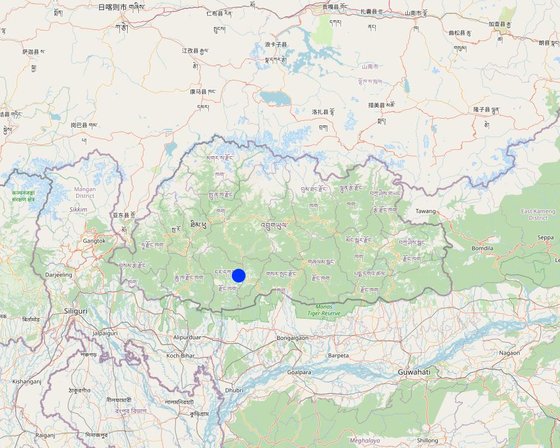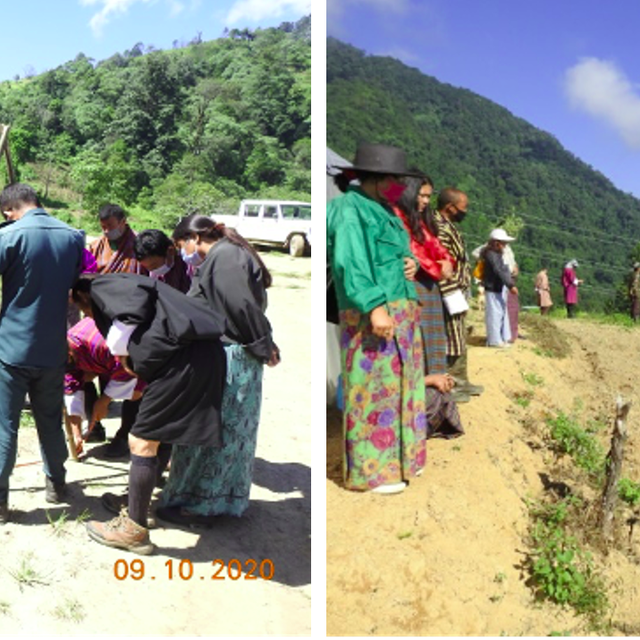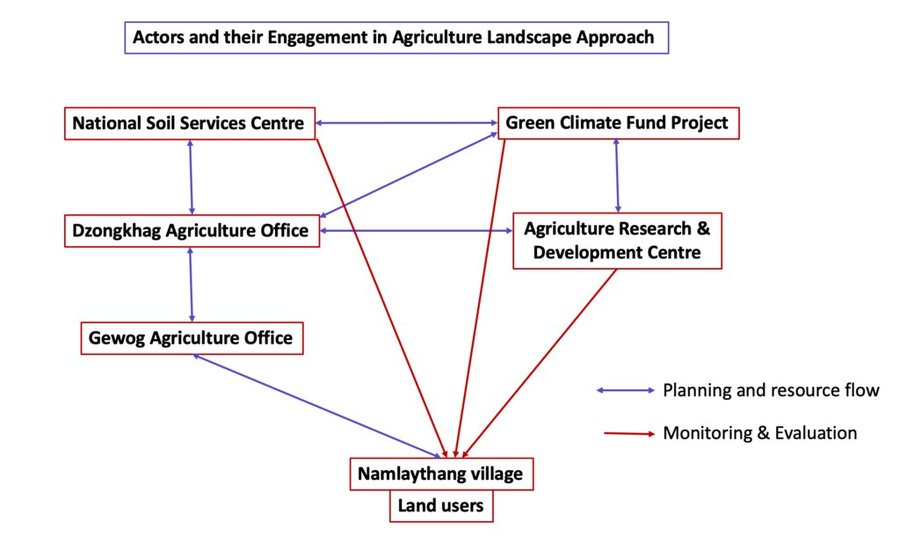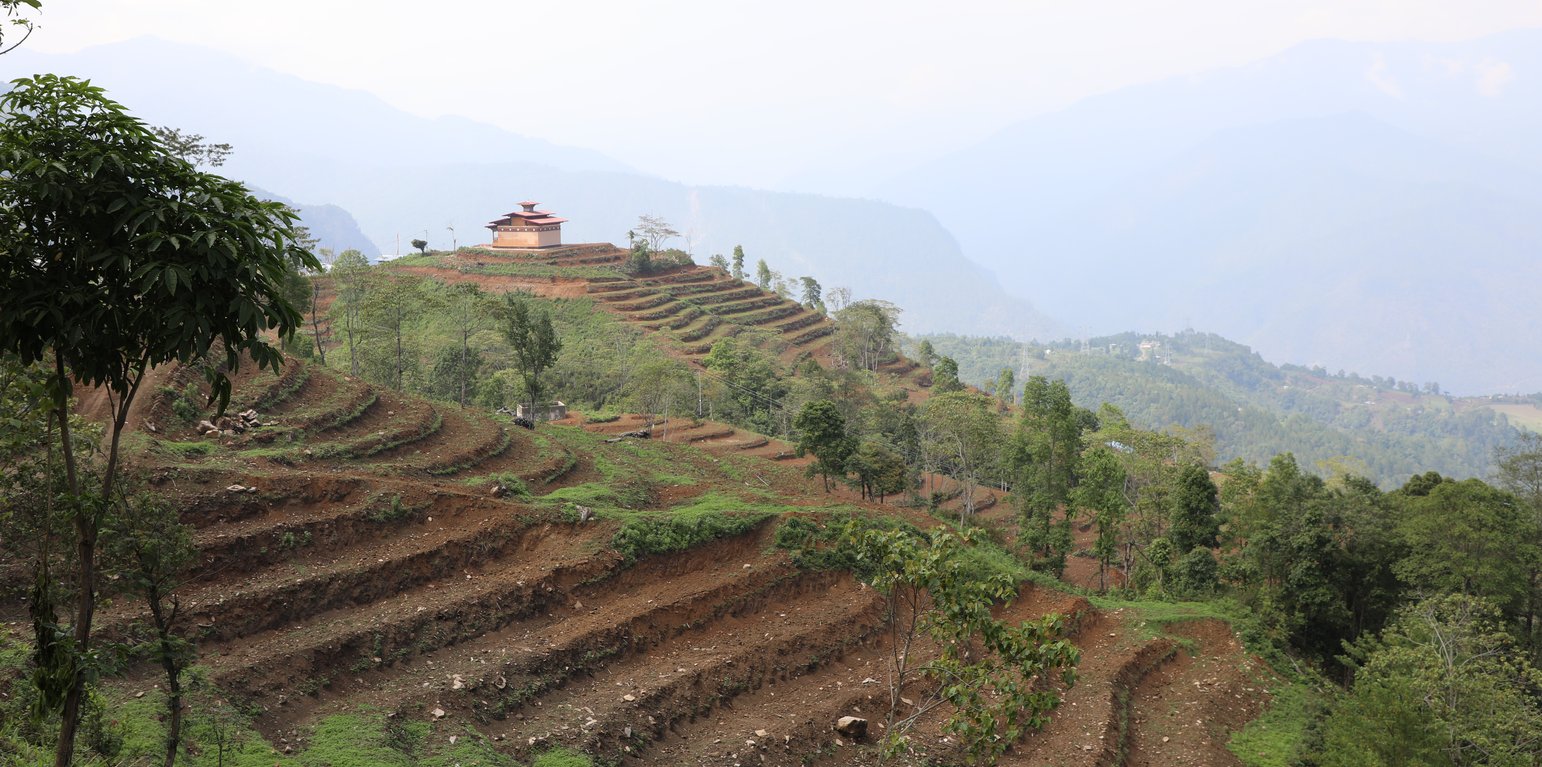Agricultural Landscape Approach for SLM Implementation
(ບູຕານ)
Yuenten Sazhi Zinchong Gi Dhoen Lu Sanam Sazhing Ngoe Zin Bae Thang (ཡུན་བརྟན་ས་གཞི་འཛིན་སྐྱོང་གི་དོན་ལུ་སོ་ནམ་ས་ཞིང་ངོས་འཛིན་འབད་ཐངས་།)
ຄຳອະທິບາຍ
The Agricultural Landscape Approach in Sustainable Land Management is a holistic and integrated strategy that focuses on managing agricultural landscapes in a sustainable manner. The approach was successfully initiated in Namlaythang village and transformed the whole agricultural landscape covering 107 acres (43 ha) while benefitting 55 resettled households.
The Agriculture Landscape Approach in Sustainable Land Management (SLM) is a holistic and integrated strategy that focuses on managing agricultural landscapes in a sustainable manner. This approach recognizes the interrelation of various elements within a landscape, including soil, water, biodiversity, and human activities, ultimately aiming to optimize the benefits derived from these interactions while minimizing negative environmental impacts.
This approach was initiated in Namlaythang village under Tsangkha gewog (block), Dagana Dzongkhag (district). Namlaythang was chosen for this approach because it is a new settlement with 55 resettled households who were granted land ranging from 1.75 to 3 acres (0.7 to 1.2 hectares) per family by His Majesty the King as per the National Rehabilitation Program. Since the area was recently cleared and converted to settlement and farming, there was a huge risk of land degradation due to direct exposure to rain and unsustainable agriculture practices. Therefore, it was not only timely to implement SLM to prevent land degradation but also appropriate to have adopted the Agricultural Landscape Approach by engaging the whole community.
The main aim of adopting the agricultural landscape approach was to bring transformational change at a scale. Too often, we plan and implement SLM interventions supported by different projects in small, localized areas and in a scattered manner. This limits the ability to scale out success (both spatially and temporally) despite being positive initiatives. The approach was also intended to facilitate a multi-stakeholder platform by bringing relevant stakeholders together to discuss common objectives and draw synergies across different agencies.
The process started by discussing the idea with the Dzongkhag and gewog agriculture offices followed by sensitization of land users on the importance of SLM and its technologies. This was followed by Participatory SLM Action planning wherein detailed action plans were prepared based on landowners’ interest, feasibility of their land and the available technologies. The next mandatory activity carried out before implementation of SLM in the field was the conduct of field based hands-on training of the land users. The main SLM technologies planned and implemented included terracing, stone bunds, hedgerows, check dams/ gully plugs and plantations. In addition, climate resilient agriculture practices were also promoted such as greenhouses, low-cost water harvesting ponds, drip irrigation sets and fruit tree plantations.
In promoting this approach and other technologies, several stakeholders were involved including the Dzongkhag and gewog agriculture offices, National Soil Services Center (NSSC), Agriculture Research and Development Center, Bajo (ARDC-Bajo), the landowners and a Green Climate Fund (GCF) Project. The agricultural offices provided the overall coordination and the facilitation role in implementing the approach and its associated technologies. The NSSC provided sensitization and training on SLM technologies and also facilitated participatory SLM Action Planning with the landowners and other stakeholders. Similarly, the ARDC-Bajo arranged material inputs for climate resilient agriculture practices and provided technical assistance to the landowners and the gewog agriculture extension officer. The GCF Project provided financial support based on the action plan.
The implementation of SLM and climate resilient agriculture practices following agricultural landscape approach in Namlaythang have been a great success. The approach has brought a transformational change at the landscape level through various SLM interventions which collectively contributed towards reduction of soil erosion and nutrient loss, conservation of soil moisture and the improvement of overall soil health and food security. The land users also feel empowered through sensitization, capacity building and their engagement in the whole process. In brief, the land users expressed their satisfaction with the approach and the impacts it has created in the agricultural landscape which is the basis of their livelihoods.
A major weakness of the approach is that there is no institution/group/cooperative formed for efficient coordination among the land users and other stakeholders which questions its sustainability.
ສະຖານທີ່

ສະຖານທີ່: Goongpa-Soomchu Chiwog, Tsangkha Gewog, Dagana Dzongkhag, ບູຕານ
ການຄັດເລືອກພື້ນທີ່ ທີ່ອີງໃສ່ຂໍ້ມູນທາງພູມີສາດ
ວັນທີເລີ່ມຕົ້ນ: 2020
ປີຂອງການສິ້ນສຸດ: n.a.
ປະເພດຂອງແນວທາງ
-
ພື້ນເມືອງ / ທ້ອງຖີ່ນ
-
ການລິເລີ່ມ ພາຍໃນປະເທດ ທີ່ຜ່ານມາ / ນະວັດຕະກໍາ
-
ພາຍໃຕ້ໂຄງການ / ແຜນງານ

Hands-on Training on SLM Technologies (Tashi Wangdi)
ເປົ້າໝາຍຂອງແນວທາງ ແລະ ການປົກປັກຮັກສາສິ່ງແວດລ້ອມ
ເປົ້າໝາຍ / ຈຸດປະສົງຫຼັກໃນການຈັດຕັ້ງປະຕິບັດແນວທາງ
To bring about transformational change through project intervention at the landscape level.
ເງື່ອນໄຂທີ່ສະໜັບສະໜູນໃຫ້ການຈັດຕັ້ງປະຕິບັດເຕັກໂນໂລຢີ ບົນພື້ນຖານແນວທາງ
-
ສັງຄົມ / ວັດທະນະທໍາ / ມາດຕະຖານ ແລະ ຄຸນຄ່າທາງສາສະໜາ: The strong community cooperation
-
ມີຄວາມສາມາດ / ເຂັ້າເຖິງຊັບພະຍາກອນດ້ານການເງິນ ແລະ ການບໍລິການ: The SLM and climate resilient agriculture technologies were implemented with financial support provided by the government through a Green Climate Fund (GCF) project
-
ການກໍ່ຕັ້ງສະຖາບັນ: The land users implement a labour-sharing system where all the land users come together to work in the field and go to the next after completion of that field. They take turns to work in the field of all the land users.
-
ການຮ່ວມມື / ການປະສານງານຂອງຜູ້ກ່ຽວຂ້ອງ: All the relevant stakeholders (Dzongkhag, Gewog, Research, NSSC, Land owners) came together in implementing SLM and climate resilient agriculture practices
-
ກ່ຽວກັບກົດໝາຍ (ສິດນໍາໃຊ້ດິນ, ສິດນໍາໃຊ້ນໍ້າ): The land is granted by His Majesty the King to the landless families under Land Use Certificate (LUC), where the land users have the right to settle, cultivate and make a living from the land, but do not have right to sell their land.
-
ນະໂຍບາຍ: National Food and Nutrition Security 2022
Bhutan Water Policy 2007
-
ການປົກຄອງທີ່ດິນ (ການຕັດສິນໃຈ, ການປະຕິບັດ ແລະ ຂໍ້ບັງຄັບ): The land users with land use right only. The land users can cultivate different crops on the land by implementing SLM technologies.
-
ຄວາມຮູ້ກ່ຽວກັບການຄຸ້ມຄອງ ທີ່ດິນແບບຍືນຍົງ, ການເຂົ້າເຖິງການສະໜັບສະໜູນ ທາງດ້ານວິຊາການ: Technical support was provided by the Gewog Agriculture Extension Officer, Agriculture Research Development Centre (ARDC) and NSSC. Moreover, there is a willingness of the farmers to gain more knowledge and experience.
-
ຕະຫຼາດ (ໃນການຊື້ວັດຖຸດິບ, ຂາຍຜະລິດຕະພັນ) ແລະ ລາຄາ: The village is well connected by the newly constructed farm road. All the farm produces can be marketed locally or can be taken to other markets
ເງື່ອນໄຂທີ່ເຊື່ອງຊ້ອນໃຫ້ການຈັດຕັ້ງປະຕິບັດເຕັກໂນໂລຢີ ບົນພື້ນຖານແນວທາງ
-
ວຽກ, ມີກໍາລັງຄົນ: Since most of the children were enrolled in schools, farm labour shortage is of major concern.
ການມີສ່ວນຮ່ວມ ແລະ ບົດບາດຂອງພາກສ່ວນທີ່ກ່ຽວຂ້ອງທີ່ມີສ່ວນຮ່ວມ
ພາລະບົດບາດຂອງພາກສ່ວນທີ່ກ່ຽວຂ້ອງ ທີ່ມີສ່ວນຮ່ວມໃນການຈັດຕັ້ງປະຕິບັດແນວທາງ
| ແມ່ນໃຜ / ພາກສ່ວນໃດ ທີ່ເປັນເຈົ້າການ ໃນການຈັດຕັ້ງປະຕິບັດ ວິທີການ? |
ລະບຸ ພາກສ່ວນທີ່ກ່ຽວຂ້ອງ |
ພັນລະນາ ບົດບາດ ໜ້າທີ່ ຂອງພາກສ່ວນທີ່ກ່ຽວຂ້ອງ |
| ຜູ້ນໍາໃຊ້ດິນໃນທ້ອງຖິ່ນ / ຊຸມຊົນທ້ອງຖິ່ນ |
Land owners |
Attend sensitization and training program on SLM technologies and implement in the field. |
| ຜູ້ຊ່ຽວຊານ ການນຄຸ້ມຄອງ ທີ່ດິນແບບຍືນຍົງ / ທີ່ປຶກສາດ້ານກະສິກໍາ |
National Soil Services Center (NSSC) |
NSSC provided training, sensitization and demonstration on SLM technologies to the land owners |
| ນັກຄົ້ນຄວ້າ |
Agriculture Research and Development Centre (ARDC) |
ARDC provided material inputs and technical assistance in implementing Climate Resilient Agriculture Practices in the field. |
| ອໍານາດ ການປົກຄອງທ້ອງຖິ່ນ |
Dzongkhag and gewog agriculture offices |
The Dzongkhag and gewog agriculture offices arranged financial and technical assistance in implementing SLM and Climate Resilient Agriculture Practices in the field while also coordinating and facilitating the whole implementation process. |
| ອົງການຈັດຕັ້ງ ສາກົນ |
United Nations Development Programme (UNDP) |
Provided financial support through a Green Climate Fund (GCF) Project |
ການລວບລວມເອົາຜູ້ນໍາໃຊ້ທີ່ດິນໃນທ້ອງຖິ່ນ/ຊຸມຊົນທ້ອງຖິ່ນ ໃນການຈັດຕັ້ງປະຕິບັດແນວທາງ ແຕ່ລະໄລຍະ
ບໍ່ມີ
ການບໍ່ປະຕິບັດ
ການຊ່ວຍເຫຼືອຈາກພາຍນອກ
ການຮ່ວມມື
ການນໍາໃໍຊ້ເອງ
ການເລີ່ມຕົ້ນ / ແຮງຈູງໃຈ
The land owners actively participate in the initial discussion on the SLM implementation following landscape approach. The process was facilitaed by the local government officials.
ການວາງແຜນ
The land onwers and the local elected leaders were involved in the participatory SLM action planning that was facilitated jointly by the Dzongkhag and the NSSC.
ການປະຕິບັດ
Land owners organized themselves into informal groups to implement SLM interventions with technical assistance from the Dzongkhag, gewog and ARDC.
ຕິດຕາມກວດກາ / ການປະເມີນຜົນ
Land owners were involved in the periodic monitoring and evaluation carried out jointly by the Dzongkhag, gewog, NSSC, ARDC and the GCF project.
ແຜ່ນວາດສະແດງ
This Flow chart shows the actors and their involvement in implementing Agricultural Landscape Approach in Namlaythang. It clearly shows that for planning and resource mobilization, other actors including the National Soil Services Centre, Green Climate Fund Project and the Agriculture Research and Development Centre worked through the Dzongkhag and Gewog Agriculture Offices. But for monitoring and evaluation, those actors can come directly to the field and carry out monitoring and evaluation without necessarily engaging the Dzongkhag and Gewog Agriculture Offices. However, if there is a need, they can inform and invite Dzongkhag and Gewog Agriculture Officials.

ຜູ້ຂຽນ: Tashi Wangdi
ການຕັດສິນໃຈໃນການເລືອກເຕັກໂນໂລຢີ ການຄຸ້ມຄອງທີ່ດິນແບບຍືນຍົງ
ການຕັດສິນໃຈໂດຍ
-
ຜູ້ນໍາໃຊ້ດິນຜູ້ດຽວ (ການລິເລີ່ມດ້ວຍຕົນເອງ)
-
ຜູ້ນໍາໃຊ້ທີ່ດິນຫຼັກ, ການສະໜັບສະໜູນ ໂດຍຜູ້ຊ່ຽວຊານ ການນໍາໃຊ້ທີ່ດິນແບບຍືນຍົງ
-
ພາກສ່ວນກ່ຽວຂ້ອງທັງໝົດ, ເປັນສ່ວນໜຶ່ງ ຂອງວິທີທາງແບບມີສ່ວນຮ່ວມ
-
ຜູ້ຊ່ຽວຊານ ຫຼັກດ້ານການຄຸ້ມຄອງ ທີ່ດິນແບບຍືນຍົງ, ມີການຕິດຕາມປຶກສາຫາລືກັບຜູ້ນໍາໃຊ້ທີ່ດິນ
-
ຊຽ່ວຊານ ສະເພາະດ້ານການຄຸ້ມຄອງ ດິນແບບຍືນຍົງຜູ້ດຽວ
-
ນັກການເມືອງ / ຜູ້ນໍາ
ການຕັດສິນໃຈບົນພື້ນຖານ
-
ປະເມີນເອກກະສານ ຄວາມຮູ້ກ່ຽວກັບ ການຄຸ້ມຄອງ ທີ່ດິນແບບຍືນຍົງ (ຫຼັກຖານທີ່ຊ່ວຍໃນການຕັດສິນໃຈ)
-
ຜົນທີ່ໄດ້ຮັບ ຈາກການຄົ້ນຄວ້າ
-
ປະສົບການສ່ວນບຸກຄົນ ແລະ ຄວາມຄິດເຫັນ (ທີ່ບໍ່ເປັນເອກກະສານ)
-
The decision was made based on the sensitization and the feasibility of the farming landscape.
ການສະໜັບສະໜູນເຕັກໂນໂລຢີ, ການສ້າງຄວາມອາດສາມາດ ແລະ ການຄຸ້ມຄອງຄວາມຮູ້
ກິດຈະກຳ ດັ່ງລຸ່ມນີ້ ແມ່ນເປັນພາກໜຶ່ງຂອງແນວທາງ
-
ການສ້າງຄວາມສາມາດ / ການຝຶກອົບຮົມ
-
ການບໍລິການໃຫ້ຄໍາປຶກສາ
-
ສະຖາບັນການສ້າງຄວາມເຂັ້ມແຂງ (ການພັດທະນາອົງການຈັດຕັ້ງ)
-
ຕິດຕາມກວດກາ ແລະ ປະເມີນຜົນ
-
ການຄົ້ນຄວ້າ
ການສ້າງຄວາມອາດສາມາດ / ຝຶກອົບຮົມ
ໄດ້ສະໜັບສະໜູນຝຶກອົບຮົມໃຫ້ແກ່ພາກສ່ວນກ່ຽວຂ້ອງດັ່ງລຸ່ມນີ້
-
ຜູ້ນໍາໃຊ້ດິນ
-
ພະນັກງານພາກສະໜາມ / ທີ່ປຶກສາ
ຮູບແບບການຝຶກອົບຮົມ
-
ການເຮັດຕົວຈິງ
-
ຕົວຕໍ່ຕົວ
-
ເນື້ອທີ່ສວນທົດລອງ
-
ກອງປະຊຸມ
-
ຫຼັກສູດ
ກວມເອົາຫົວຂໍ້
SLM Technologies (Terracing, hedgerows, stone bunds, plantations and check dams)
ການບໍລິການທາງດ້ານການໃຫ້ຄໍາປຶກສາ
ໄດ້ຮັບການບໍລິການທາງດ້ານການໃຫ້ຄໍາປຶກສາ
-
ໃນພື້ນທີ່ຂອງຜູ້ນໍາໃຊ້ດິນ
-
ສູນຄົ້ນຄວ້າ
Advisory services were provided by the agriculture advisers from the Dzongkhag and Gewog Agriculture offices.
ຄວາມເຂັ້ມແຂງຂອງສະຖາບັນ
ສະຖາບັນ ໄດ້ຮັບການສ້າງຄວາມເຂັ້ມແຂງ
-
ບໍ່ມີ
-
ມີ, ໜ້ອຍໜຶ່ງ
-
ມີ, ພໍສົມຄວນ
-
ມີ, ຫຼາຍ
ໃນລະດັບດັ່ງລຸ່ມນີ້
-
ທ້ອງຖິ່ນ
-
ລະດັບພາກພື້ນ
-
ແຫ່ງຊາດ
ອະທິບາຍສະຖາບັນ, ພາລະບົດບາດແລະຄວາມຮັບຜິດຊອບ, ສະມາຊິກ, ແລະອື່ນໆ.
There is no new institution established within the approach. However, various institutions were involved in promoting the technologies under the approach. At the local level, Dzongkhag and Gewog agriculture offices were involved in overall coordination and provided technical guidance. The Dzongkhag agriculture offices were also involved in sourcing funds for the implementation of the approach. Regional Agriculture Research and Development Center, Bajo (ARDC-Bajo) arranged material inputs for climate-resilient agriculture practices and provided technical assistance to the gewog agriculture extension officer and land owners. National Soil Service Center (NSSC) provided sensitization and training on SLM technologies and also facilitated participatory SLM Action Planning with the land owners and other stakeholders. The Green Climate Fund (GCF) Project was the main funding agency providing financial support based on the action plan.
ຮູບແບບການສະໜັບສະໜູນ
-
ທາງດ້ານການເງິນ
-
ການສ້າງຄວາມອາດສາມາດ / ການຝຶກອົບຮົມ
-
ອຸປະກອນ
ລາຍລະອຽດເພີ່ມເຕີມ
The major financial support was provided by the GCF project and minor fund support was provided by the government for the implementation of the approach. Various stakeholders including NSSC, ARDC-Bajo, Dzongkhag and gewog offices were involved in the capacity building of the land owners. However, gewog offices were involved constantly due to the proximity and direct contact with the land owners. Equipment for the construction of greenhouses, low-cost water harvesting ponds, drip irrigation, terracing, stone bunds, hedgerows and check dams were provided during the implementation of technologies under the approach.
ການຕິດຕາມ ແລະ ປະເມີນຜົນ
The monitoring and evaluation are periodically done by the Dzongkhag Agriculture Office, NSSC and the Project Management Unit of the GCF Project.
ການສະໜັບສະໜູນທາງດ້ານການເງິນ ແລະ ອຸປະກອນຈາກພາຍນອກ
ງົບປະມານປະຈຳປີ ໃນກິດຈະກຳ ການຄຸ້ມຄອງທີ່ດິນແບບຍືນຍົງ ທີ່ເປັນສະກຸນເງິນໂດລາ
-
< 2,000
-
2,000-10,000
-
10,000-100,000
-
100,000-1,000,000
-
> 1,000,000
Precise annual budget: n.a.
The main funding source is GCF project
ການບໍລິການ ຫຼື ສິ່ງກະຕຸກຊຸກຍູ້ ດັ່ງລຸ່ມນີ້ ແມ່ນໄດ້ສະໜອງໂດຍຜູ້ນຳໃຊ້ທີ່ດິນເອງ
-
ການສະໜັບສະໜູນ ທາງດ້ານການເງິນ / ອຸປະກອນ ສະໜອງໃຫ້ແກ່ຜູ້ນໍາທີ່ດິນ
-
ຫຼຸດປັດໃຈນໍາເຂົ້າ
-
ສິນເຊື່ອ
-
ສິ່ງຈູງໃຈ ຫຼື ເຄື່ອງມືອື່ນໆ
ເງິນສະໜັບສະໜູນອຸປະກອນ / ສະໜອງໃຫ້ຜູ້ຊົມໃຊ້ທີ່ດິນ
The implementation of all the SLM technologies was funded by the GCF project. Besides, land owners also received material supports such as greenhouses, low cost water harvesting ponds, drip irrigation sets, seeds and seedlings with financial support from the project and government.
ງົບປະມານບາງສ່ວນ
ງົບປະມານເຕັມສ່ວນ
ກະສິກໍາ: ແນວພັນ, ແກ່ນພັນ
Vegetable seeds
ການກໍ່ສ້າງ: ຫີນ
For stone check dam construction in the gullies
ການກໍ່ສ້າງ: ຫີນ: ໄມ້
For log check dam construction in the gullies
Greenhouse
Prefabricated Greenhouse sets
ແຮງງານຂອງຜູ້ນໍ້າໃຊ້ທີ່ດິນ
-
ການອາສາ
-
ລ້ຽງເຂົ້າ - ອາຫານ
-
ຈ່າຍເປັນເງິນສົດ
-
ໄດ້ຮັບການສະໜັບສະໜູນ ອຸປະກອນດ້ານອື່ນ
ສີ່ງກະຕຸກຊຸກຍູ້ອື່ນໆ
The SLM Technologies and Climate Resilient Agriculture practices were provided in line with the SLM Guidelines and Best Practices 2021 and the Cost Sharing Mechanisms of the Ministry of Agriculture and Livestock.
ການວິເຄາະຜົນກະທົບ ແລະ ສະຫຼຸບລວມ
ຜົນກະທົບຂອງການນໍາໃຊ້ແນວທາງ
ບໍ່
ມີ, ໜ້ອຍໜຶ່ງ
ມີ, ພໍສົມຄວນ
ມີ, ຫຼາຍ
ວິທີທາງ ຊ່ວຍຊຸກຍູ້ ຜູ້ນຳໃຊ້ທີ່ດິນທ້ອງຖີ່ນ, ໃນການປັບປຸງ ການມີສ່ວນຮ່ວມ ຂອງຜູ້ທີ່ກ່ຽວຂ້ອງ ບໍ່?
The approach empowered local land users through capacity building and self-mobilization in implementing SLM technologies in the field.
ການຈັດຕັ້ງປະຕິບັດ ວິທີທາງ ສາມາດຊ່ວຍຜູ້ນໍາໃຊ້ທີ່ດິນ ໃນການຈັດຕັ້ງປະຕິບັດ ແລະ ບໍາລຸງຮັກສາ ເຕັກໂນໂລຢີ ການຄຸ້ມຄອງ ທີ່ດິນແບບຍືນຍົງໄດ້ບໍ?
The landscape approach encouraged all the land owners to participate and implement SLM Technologies.
ການນໍາໃຊ້ ວິທີທາງ ສາມາດປັບປຸງ ການປະສານງານ ແລະ ຄ່າໃຊ້ຈ່າຍ ການຈັດຕັ້ງປະຕິບັດ ທີ່ມີປະສິດທິພາບ ຂອງການຄຸ້ມຄອງ ທີ່ດິນແບບຍືດຍົງໄດ້ບໍ່?
The landscape approach enabled stakeholders to converge and coordinate better planning and implementation by avoiding duplication and harnessing synergy and complimentary effects.
ການນໍາໃຊ້ ວິທີທາງ ສາມາດປັບປຸງຄວາມຮູ້ ແລະ ຄວາມສາມາດຂອງຜູ້ນໍາໃຊ້ທີ່ດິນ ໃນການປະຕິບັດ ການຄຸ້ມຄອງ ທີ່ດິນແບບຍືດຍົງໄດ້ບໍ່?
The training and technical support were provided to the land users improving their knowledge and skills to implement SLM technologies.
ການນໍາໃຊ້ ວິທີທາງ ສາມາດສ້າງຄວາມເຂັ້ມແຂງ ໃຫ້ສະຖາບັນການຈັດຕັ້ງ, ການຮ່ວມມື ລະຫວ່າງພາກສ່ວນທີ່ກ່ຽວຂ້ອງບໍ່?
The landscape approach greatly enhanced collaboration between the existing stakeholders as it brought all the relevant stakeholders together to improve the land on which people depend for their livelihoods. For example, the gewog extension officers were trained by NSSC and ARDC-Bajo to disseminate technical information to the land users. However, there is no institution/group formed as part of the approach through which land users communicate within themselves or with other stakeholders to maintain or improve the technologies under the approach.
ການນໍາໃຊ້ ວິທີທາງ ໄດ້ປັບປຸງ ການຄໍ້າປະກັນສະບຽງອາຫານ ຫຼື ປັບປຸງໂຄສະນາການໄດ້ບໍ່?
Through this approach different SLM and Climate Resilient Agriculture practices were implemented which ensures better soil health, better soil productivity and improved food security.
ການນໍາໃຊ້ ວິທີທາງ ໄດ້ປັບປຸງ ການເຂົ້າເຖິງນໍ້າ ແລະ ສາຂາພິບານໄດ້ບໍ່?
Through this approach, certain supports were given to improve access and better utilization of water resource.
ການຈັດຕັ້ງປະຕິບັດ ວິທີທາງ ສາມາດສ້າງຄວາມອາດສາມາດໃຫ້ຜູ້ນໍາໃຊ້ດິນ ໃນການປັບຕົວ ຕໍ່ການປ່ຽນແປງດິນຟ້າອາກາດ / ຫຼດຜ່ອນຄວາມສ່ຽງທາງໄພພິບັດໄດ້ບໍ?
The landscape approach did improve the capacity of the land users through training and their active participation in the implementation of SLM technologies in the field.
ການນໍາໃຊ້ ວິທີທາງ ໄດ້ປັບປຸງ ການຈ້າງງານ, ໂອກາດ ໃນການສ້າງລາຍຮັບບໍ່?
The landscape approach did contribute moderately to employment and income opportunities as some of the SLM technologies encouraged land owners to work their land and produce more for cash income.
ສິ່ງກະຕຸກຊຸກຍູ້ໃຫ້ຜູ້ນໍາໃຊ້ທີ່ດິນ ໃນການປະຕິບັດການຄຸ້ມຄອງທີ່ດິນແບບຍືນຍົງ
-
ການຜະລິດເພີ່ມຂຶ້ນ
-
ກໍາໄລເພີ່ມຂຶ້ນ (ຄວາມສາມາດ), ການປັບປຸງຄ່າໃຊ້ຈ່າຍ, ຜົນປະໂຫຍດ, ອັດຕາສ່ວນ
-
ຫຼຸດຜ່ອນດິນເຊື່ອມໂຊມ
-
ຫຼຸດຜ່ອນຄວາມສ່ຽງຂອງໄພພິບັດ
-
ການຫຼຸດຜ່ອນພາລະວຽກ
-
ການຊໍາລະເງິນ / ເງິນອຸດໜູນ
-
ກົດລະບຽບແລະລະບຽບການ (ລະອຽດ) / ການບັງຄັບໃຊ້
-
ກຽດສັກສີ, ຄວາມກົດດັນທາງສັງຄົມ / ການຕິດຕໍ່ກັນທາງສັງຄົມ
-
ລວມເຂົ້ານໍາກັນກັບການເຄື່ອນໄຫວ / ໂຄງການ / ກຸ່ມ / ເຄືອຂ່າຍ
-
ຄວາມຮັບຮູ້ ທາງສີ່ງແວດລ້ອມ
-
ພາສີ ແລະ ຄວາມເຊື່ອຖື, ສົມບັດສິນທໍາ
-
ການປັບປຸງ ຄວາມຮູ້ ແລະ ຄວາມສາມາດ ຂອງການຄຸ້ມຄອງ ທີ່ດິນແບບຍືນຍົງ
-
ການປັບປຸງຄວາມງົດງາມ
-
ການຫຼຸດຜ່ອນຂໍ້ຂັດແຍ່ງ
ຄວາມຍືນຍົງຂອງການຈັດຕັ້ງປະຕິບັດກິດຈະກໍາຂອງແນວທາງ
ຜູ້ນໍາໃຊ້ທີ່ດິນ ສາມາດຈັດຕັ້ງປະຕິບັດຕາມແນວທາງໄດ້ເອງບໍ່ (ໂດຍປາດສະຈາກການສະໜັບສະໜູນຈາກພາກສ່ວນພາຍນອກ)?
Based on the experience that land users have gained over the past 5 years, the land owners can sustain the technology implemented through this approach without external support as the maintenance cost is very minimal. The land owners feel that they can carry out maintenance on their own.
ບົດສະຫຼຸບ ແລະ ບົດຮຽນທີ່ໄດ້ຮັບ
ຄວາມເຂັ້ມແຂງ: ທັດສະນະມູມມອງ ຂອງຜູ້ນໍາໃຊ້ທີ່ດິນ
-
The community has not experienced any reported problems related to landslides, indicating the positive impact of terracing and check dams that have ensured the overall stability and sustainability of the area.
-
The land users can make a living from increased agricultural production and cash income.
-
Since the land was granted by His Majesty the King, the community receives so much of attention and technical support from different agencies. This has enabled the land users to avail much needed SLM interventions through the landscape approach.
ຄວາມເຂັ້ມແຂງ: ທັດສະນະມຸມມອງ ຂອງຜູ້ປ້ອນຂໍ້ມູນເອງ
-
The land users are exposed to new knowledge and skills to implement SLM technologies, which could serve as a model for further replication in other areas.
-
There is a transformational change at the landscape level, which otherwise becomes difficult if landscape approach was not adopted.
ຈຸດອ່ອນ / ຂໍ້ເສຍ / ຄວາມສ່ຽງ: ທັດສະນະມູມມອງ ຂອງຜູ້ນໍາໃຊ້ທີ່ດິນວິທີການແກ້ໄຂແນວໃດ
-
No institution/group/cooperative has been formed for efficient coordination among the land users.
By forming a permanent or formal group to continue the implementation and management of the SLM technologies.
-
Limited integration of livestock and forest related technologies due to limited fund.
Explore additional funding source from other sources such as Bhutan Trust Fund for Environmental Conservation (BTFEC) and UNDP Small Grant Project (SGP) to support implementation of livestock and forestry activities.
ຈຸດອ່ອນ / ຂໍ້ເສຍ / ຄວາມສ່ຽງ: ທັດສະນະມຸມມອງ ຂອງຜູ້ປ້ອນຂໍ້ມູນເອງວິທີການແກ້ໄຂແນວໃດ
-
No lead agency or personnel to initiate group formation.
The Gewog Agriculture Extension Officer could lead the group formation if they feel the need.
-
Lack of frequent monitoring of the implemented SLM technologies leading to reduced performance in terms of agriculture production and maintenance of the SLM technologies.
Ensure timely monotiring from the Gewog and Dzongkhag Agriculture offices
ເອກກະສານອ້າງອີງ
ການທົບທວນຄືນ
-
William Critchley
-
Rima Mekdaschi Studer
-
Joana Eichenberger
ວັນທີຂອງການປະຕິບັດ: July 12, 2023
ປັບປຸງລ່າສຸດ: May 30, 2024
ບຸກຄົນທີ່ສໍາຄັນ
-
Damchoe Dorji - ຜູ້ນໍາໃຊ້ທີ່ດິນ
-
Tsagay - ຜູ້ນໍາໃຊ້ທີ່ດິນ
-
Jigme Dema - ຜູ້ນໍາໃຊ້ທີ່ດິນ
-
Yeshi Wangda - ຜູ້ນໍາໃຊ້ທີ່ດິນ
-
Nyagay Norbu - ຜູ້ນໍາໃຊ້ທີ່ດິນ
ການບັນຍາຍລາຍລະອຽດ ໃນຖານຂໍ້ມູນ ຂອງ WOCAT
ຂໍ້ມູນການເຊື່ອມໂຍງຂໍ້ມູນການຄຸ້ມຄອງການນໍາໃຊ້ດິນແບບຍືນຍົງ
ເອກກະສານ ແມ່ນໄດ້ອໍານວຍຄວາມສະດວກໂດຍ
ສະຖາບັນ
- National Soil Services Centre, Department of Agriculture, Ministry of Agriculture & Livestock (NSSC) - ບູຕານ
ໂຄງການ
- Strengthening national-level institutional and professional capacities of country Parties towards enhanced UNCCD monitoring and reporting – GEF 7 EA Umbrella II (GEF 7 UNCCD Enabling Activities_Umbrella II)
ການອ້າງອີງທີ່ສໍາຄັນ
-
Sustainable Land Management (SLM) Guidelines and Best Practices 2021, The National Soil Services Center, Department of Agriculture, Ministry of Agricultue and Livestock: The National Soil Services Center, Semtokha, Thimphu, Bhutan
ເຊື່ອມໂຍງກັບ ຂໍ້ມູນຕ່າງໆ ທີ່ກ່ຽວຂ້ອງທີ່ມີ






